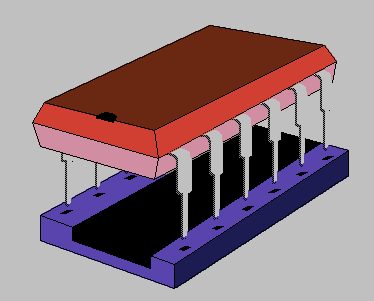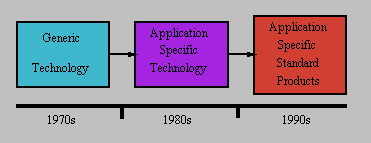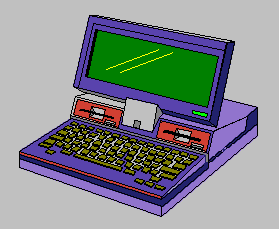Application Specific Integrated Circuits (ASSPs)
� Mercury Communications Ltd - January 1993
![]() 2007
network writings:
2007
network writings:
![]() My
TechnologyInside blog
My
TechnologyInside blog
The advent of microchips, known as Application Specific Standard Products (ASSPs), dedicated to specific telecommunication functions, will have a profound effect on the telecommunications market segment in the 1990s. Acceptance of world-wide standards allows semiconductor vendors to justify the design of chip-sets that support these new standards. Availability of these devices enables even the smallest company to benefit from high integration and get products to the market fast. This issue explains the background to these changes and discusses the possible impact to the telecommunication industry.
A Brief History of Semiconductors
The 1960s saw a revolution in the ability of electronic equipment manufacturers to miniaturise products following the invention of the transistor. Initially, assembly of these devices into products such as portable radios was achieved using point-to-point wiring on chassis-based tag-strips as used throughout the earlier valve era.
Better methods were required, and American inventiveness led to the concept of the now ubiquitous printed circuit board,or PCB, as it is now commonly known. The drive for further miniaturisation led to the invention of the integrated circuit (IC) by Jack Kilby of Texas Instruments in 1958. This entailed the fabrication of several interconnected transistors and components on a single silicon substrate. Now, complete functionally complex circuits could be assembled within a single small package such as in Figure 1, which is shown larger than life size.
The invention of the IC was the catalyst for all the electronics advances of the last three decades. Throughout the 1960s and 1970s, the level of integration increased at pace and this resulted in the invention of the now well known microprocessor or 'computer on a chip' in 1974 by Intel.

Figure 1 - A Simple Dual-in-Line IC
By the middle of the 1970s, there were literally thousands of ICs available from hundreds of semiconductor companies. This enabled electronic equipment manufacturers to create IC based products spanning applications in markets as diverse as military, consumer, industrial, transport and, of course, communications. The invention of the microprocessor enabled the level of sophistication of electronic products to rocket. This was possible because the microprocessor brought all the benefits of computer software control to even the lowest cost product, such as door chimes and singing greetings cards! The largest market for microprocessors, apart from the now commonly encountered PC and Macs, is in embedded applications. These are applications where a user does not know that a microprocessor is being employed. Consumer products such as VCRs and microwave ovens fall into this application class.
Most of these new microprocessor based products were designed and assembled using standard, off-the-shelf families of ICs that were available to anyone. All that was required to develop new and exciting feature-rich products was an understanding of digital design and programming techniques. By the middle of the 1980s, this inevitably resulted in considerable similarity of features, function and performance, in end-products from competitive manufacturers. Any feature achieved through programming could be easily emulated by competitors. Saturation and commodity products had arrived and suddenly it was not possible to differentiate products through software alone.
Designing ICs
In the 1970s the development of a new IC was an expensive and time consuming affair. There were few experienced IC designers around and there were even fewer computer aided design(CAD) software packages to help them with their work. Circuit diagrams extended to hundreds of square feet and design time to years. Because of the inherent complexity of ICs, which could contain upwards of 100,000 transistors, and their reliance on non-computer aided design methodology, there was a significant probability that the design would not work first time around. Most designs required two, three, or maybe more iterations before the final IC was ready for volume production. Design and production tooling costs could run to hundreds of thousands of pounds. So to achieve an acceptable end sell-price, these high costs needed to be amortised across very high production volumes, typically millions of units. This led to IC design being dominated by large multi-national semiconductor companies. Only their high production volumes, targeted at world markets, were sufficient to support the amortised high costs of IC design and manufacture.
The Evolution of CAD Tools
Because designing ICs was a labour intensive and slow process, design costs were very high in the 1970s. This led to numerous start-up companies putting considerable energy into the development of automated tools. Throughout the 1980s, IC design software programs of ever increasing capability were marketed by such companies as Mentor, Dazix, Racal Redac, and Cadence. These included graphics programs that enabled the entering of circuit diagrams; simulator programs that allowed a designer to fully evaluate the performance of a design prior to making silicon; and place-and-route software that automatically converted a logic diagram to an IC physical layout format. These advances allowed semiconductor vendors to design more and more complex devices in shorter and shorter times. Computerisation of the design process went hand-in-hand with silicon process advances whereby more and more transistors could be squeezed into each square millimetre of silicon.
Anyone Could Now Design an IC
It was not long before end-equipment manufacturers realised that the advances being made in CAD software would allow them to design their own proprietary ICs. These could be customised to their own needs and used instead of off-the-shelf ICs available to all of their competitors. IC design that had previously been undertaken almost exclusively by an elite group was, for the first time, available to anyone. By the mid 1980s it was easy for an electronics company to purchase CAD tools and hire engineers with design experience so that they could design Application Specific Integrated Circuits (ASICs) themselves. Semiconductor companies were then relegated to only manufacturing the ASICs. The application value-added knowledge now lay with system companies, not the semiconductor vendors. This was very much to the system houses' advantage as products designed using only generic off-the-shelf ICs resulted in products that were very similar to their competitors. ASIC technology created such a competitive edge and became so popular that up to 70% of large electronic equipment manufacturers world-wide designed their own ICs. By these means they not only improved the performance of their products, but, also reduced piece-part count, reduced costs, improved reliability, and differentiated their end-products in an increasingly competitive world market place.
In the telecommunications world, all of the major equipment manufacturers used ASICs in association with microprocessors to form the core of their electronics systems. In practise, upon the general release of any new standard, the only way a manufacturer could produce compatible equipment was by using ASICs as there were no off-the-shelf products available.
Synchronous transmission, in the form of SDH, was a prime example of this problem. When SDH standards where agreed in 1988, no semiconductor manufacturer was producing off-the-shelf parts. If a telecommunications equipment manufacturer such as Alcatel, Ericsson, or GPT, wanted to produce equipment at an early stage to gain market advantage, they needed to design the SDH compliant ASICs themselves. This they did, although several IC manufacturers are now in full production of SDH chip sets.
It should be remembered that designing complex ASICs requires a large amount of money, design resource, an intimate knowledge of the standard and, not least, courage!
The Rise of ASSPs
It didn't take too long for semiconductor vendors to discover that, with so many of their customers designing ASICs, many of the designs must have similar or common functionality.

Figure 2 - The Progress of IC Technology
By way of an example, if ten disk-drive manufacturers were designing disk-controllers to the PC IDE interface standard, then their designs must, by definition, have equal functionality. It would therefore be an excellent market opportunity for a vendor to design an IDE disk-controller themselves and sell it to those ten manufacturers as a standard part. This type of application dedicated IC is known by the generic title of Application Specific Standard Products (ASSPs).
To provide a marketing edge, the vendor could customise the standard design to an individual customer's need, at a charge of course! This would considerably benefit their customers by reducing design costs and time-to-market, while at the same time benefiting the semiconductor vendor by increasing sales and throughput. It would also allow them to increase profit margins through the inclusion of value-added application knowledge. The pooling of production volumes would clearly reduce piece-part costs as well. In many ways, the IC technology circle had gone round full circle.
It has not just been semiconductor vendors who jumped on this particular bandwagon, many end-equipment manufacturers have done so as well. They not only have the extensive knowledge of the application and standards, but also have the experience to design complex ICs. This has led to the formation of a plethora of small semiconductor suppliers, mainly in the USA, that were set up by fall-out managers of equipment builders. These companies specialise in particular application areas and usually sub-contract IC manufacture to larger semiconductor manufacturers. The formation trigger is often an innovative idea or the announcement of a new standard such as SDH, CDDI or ATM.
This trend back to standard, application oriented ICs has been very strong in all application areas in the early 1990s, and will have a profound impact on the telecommunication markets.
ASSPs and the Telecommunications Industry
Communications oriented ICs have been available since the dawn of the semiconductor industry so what is different now?
Early communications chips were very basic generic devices concerned with such things as RS-232 or HDLC protocol control. They mostly provided serial and parallel interface ports for microcomputers. They had little relevance, except in a peripheral way, to PSTNs. It was left to major telecommunications manufacturers such as Alcatel, NT, GPT, AT&T and Ericsson to develop their own ASICs to support new standards. As the cost of developing these technologies was very high, they were not about to licence them to competitors! The inevitable result of this was that often only large, multinational, manufacturers have been able to bring out new-standard compatible equipment. Supplier choice for operators has therefore been narrow, thus allowing manufacturers to hold prices high. The availability of ASSPs that are compliant with world standards, will change this.
In 1992, it is possible for any small to medium manufacturer to produce equipment compliant to standards using 3rd party chip-sets as the core of their products. This will open up markets by allowing open competition, arguably for the first time, based exclusively on features and price. One key result will be to drive prices down.

PCs, an Industry Radically Affected by ASSPs
The power of ASSPs is best illustrated by what has happened in the last few years in the PC market. Here, chip-sets consisting of two or three complex ICs have replaced over one hundred individual ICs to form a functional PC. This innovation fuelled the Pacific-rim clone manufacturers and made the PC a commodity product. The result was that IBM and COMPAQ, both major multinationals, who once led the PC market, were displaced within a year by smaller, more efficient, companies who could operate at lower gross margins of less than 15%. Both of these companies justified high sell-prices by differentiating themselves on technology and quality. The availability of chip sets gave access to an equal, and sometimes better, level of technology to any manufacturer, thus eroding IBM and Compaq's position. It is only now that both of these companies are beginning to fight back, but only through matching the sell prices of the clone makers. The lesson is that image, technology and quality cannot compensate in a commodity market for sell prices that are significantly higher than street market prices.
Example ASSPs
Specialist ASSP chip vendors are already supplying standard off-the-shelf chip-sets for the following telecommunication application areas, and this is a far from exhaustive list:
- GSM & DECT 1800: The Groupe Sp�ciale Mobile pan-European digital cellular radio and the DECT 1800 PCN standard will rely on the availability of highly integrated and low-cost chip-sets suitable for hand-set use. These state-of-the-art chips will combine wireless, analogue and digital technology. Many are now available from semiconductor manufacturers such as Motorola, Siemens, and VLSI Technology.
- Spread Spectrum Radio: As discussed in TW #1, spread spectrum radio has found application in wireless LANS, but could also find a niche in PCN, cellular and low earth orbit satellite applications. Several chip sets are available.
- Wireless LANs: Requiring similar technology to that used for GSM but with reduced functionality, wireless LAN links between workstations or portable computers are dependent on chip-set availability. In the UK, GEC Plessey Semiconductors has been making headway in chip design. Spread spectrum, CDMA, technology has also taken hold in this market area.
- CDDI: There is tremendous interest in producing a transmission technology that would allow standard telephone twisted-pair copper cable to carry data at up to 100Mbit/s. Several transceiver chips are to be launched in the second half of 1992. Companies who are pushing these devices are National Semiconductor, AT&T, Motorola, AMD and ChipCom.
- Data Compression: New standards in video conferencing have been defined under the compliance umbrella standard H.320, based on H.261 of 1990, and Motion/Joint Picture Expert Group (MPEG & JPEG), which govern moving and still picture compression for PC multimedia applications. This has created tremendous activity in the semiconductor world. Today, two or three video digital signal processing (DSP) chips handle tasks that once required more than ten chips. Compression Labs, Integrated Information Technology, Intel (in partnership with Picturetel), Motorola, LSI Logic, C-Cube and several Japanese companies are actively involved in this market.
- SDH: The synchronous digital hierarchy for high-speed digital communications in the PSTN arena requires highly integrated chip-sets. SDH equipment cannot be built cost effectively from off-the-shelf components. For example, the following companies are supplying SONET and SDH products, TransSwitch Inc., Pacific Micro-electronics Centre, National Semiconductors, VLSI Technology and Texas Instruments. Several of these are pushing IC technology to extremes by using gallium arsenide instead of silicon to produce chips working at 2.4Gbit/s STM-16 rates.
- ATM: Asynchronous transfer mode switches are already being marketed for private use in the USA and several semiconductor companies are supplying ATM compatible chip sets: TranSwitch Inc. and VLSI Technology to name but two.
- SMDS: The first manufacturer to market a chip set for use with Bellcomm's Switched Multi-megabit Data Service is Base2 Inc. These become available in Q2 1992.
To Finish
The advent of accepted world standards, resulting in the availability of off-the-shelf chip-sets will have a radical impact over the next five years on telecommunications equipment markets. It is those companies who are willing to understand these changes a nd take advantage of them that will preserve market share and see the best growth in the 1990s
